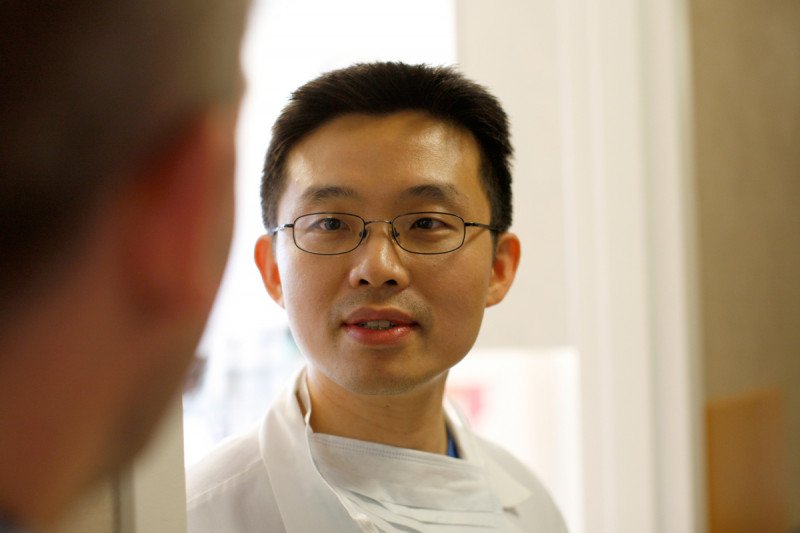
At Memorial Sloan Kettering, we are experienced in diagnosing and treating people with Kaposi sarcoma (KS), and were among the nation’s first institutions to treat people with the condition as a result of HIV/AIDS-related disease. Each year we treat dozens of people with KS.
While the illness cannot be cured, it can be managed. Our individualized and multidisciplinary approach enables us to help many people achieve long-term remission and relief from symptoms.
Our researchers also conduct clinical trials to study novel therapies for KS. Your doctor may suggest that you participate in one of these clinical trials, especially if your current regimen is not working well.
Diagnosing Kaposi Sarcoma
After asking about your medical history and examining your skin for the appearance of lesions (including your nose and rectum if you have symptoms in these areas), we will likely order a biopsy, in which a highly trained pathologist examines small tissue samples from one or more of these lesions under a microscope.
Your doctor also may recommend the following tests:
- Bronchoscopy: In this procedure, performed while patients are under anesthesia, a pulmonologist places a small tube through the nose or mouth into the bronchial passages to examine the lungs.
- Endoscopy: A gastroenterologist passes a thin, flexible tube with a light and camera at the tip, called an endoscope, into the throat and gastrointestinal tract to look for lesions in the stomach and intestines. This procedure is performed while patients are sedated.
- Colonoscopy: This involves following a special clear-liquid diet and taking medicine to clear the bowel, after which a gastroenterologist inserts a tube with a light and camera on its tip through the rectum into the colon. It is also performed while patients are sedated.
- CT scan: This test allows doctors to determine if the cancer has spread to the lungs, lymph nodes, or liver.
Staging Kaposi Sarcoma
Staging cancer is a way of describing the size of a tumor and how far it has spread or progressed.
Because KS often appears in multiple places in the body at the same time, it is staged differently from other cancers. When KS is AIDS-related, we use the AIDS Clinical Trial Group staging system, which considers the following elements:
- Location and extent of the lesions (whether they affect just the skin or mouth or have spread to internal organs)
- Status of the immune system based on the number of white blood cells, called CD4 cells, present in the blood
- Symptoms such as diarrhea, fever, night sweats, or unexplained weight loss, which suggest systemic involvement
Treatment of Kaposi Sarcoma
We will develop an individualized treatment plan for you based on the cause of your disease and the location, size, and sensitivity of the affected areas.
If you have HIV, we may prescribe highly active antiretroviral therapy (HAART) to strengthen your immune system and shrink KS lesions. The choice of treatment may also be influenced by the severity of the underlying HIV infection and other health issues. Many people can achieve remission with HAART, but lesions may reappear after treatment has ended.
If your KS is caused by taking immune-suppressing drugs to prevent rejection of a transplanted organ, we may suggest adjusting your medication dose or trying a different drug.
In the past, doctors treated lesions with injections of a chemotherapy drug (an approach called intralesional chemotherapy), but they rarely use this treatment now because it is quite painful and can lead to scarring. Today we treat most types of KS with one or more of the following approaches:
- Local therapy: A topical therapy such as alitretinoin gel can be effective in minimizing or stopping skin lesions that are small and limited in number from progressing. Approved by the FDA for the treatment of KS in 1999, this gel contains a retinoid (a chemical derived from vitamin A) that slows cell growth.
- Excision: Small and shallow lesions may be surgically removed, along with some adjoining tissue. However, many lesions reappear after they are excised.
- Radiation: In this approach, radiation oncologists shrink lesions on the skin or in the mouth with moderate doses of radiation given once a week for several weeks. Our doctors may use electron beam radiation therapy (EBRT) to deliver higher doses of radiation to lesions that affect large areas of the skin.
- Chemotherapy: Your doctor may recommend chemotherapy, a systemic treatment that kills cancer cells throughout the body, if you have a large number of skin lesions or rapid disease progression, or if KS lesions have spread to your gastrointestinal tract or another internal organ. The most commonly used chemotherapy drug for KS, liposomal doxorubicin, is given by intravenous infusion every two to three weeks.
We’re available 24 hours a day, 7 days a week